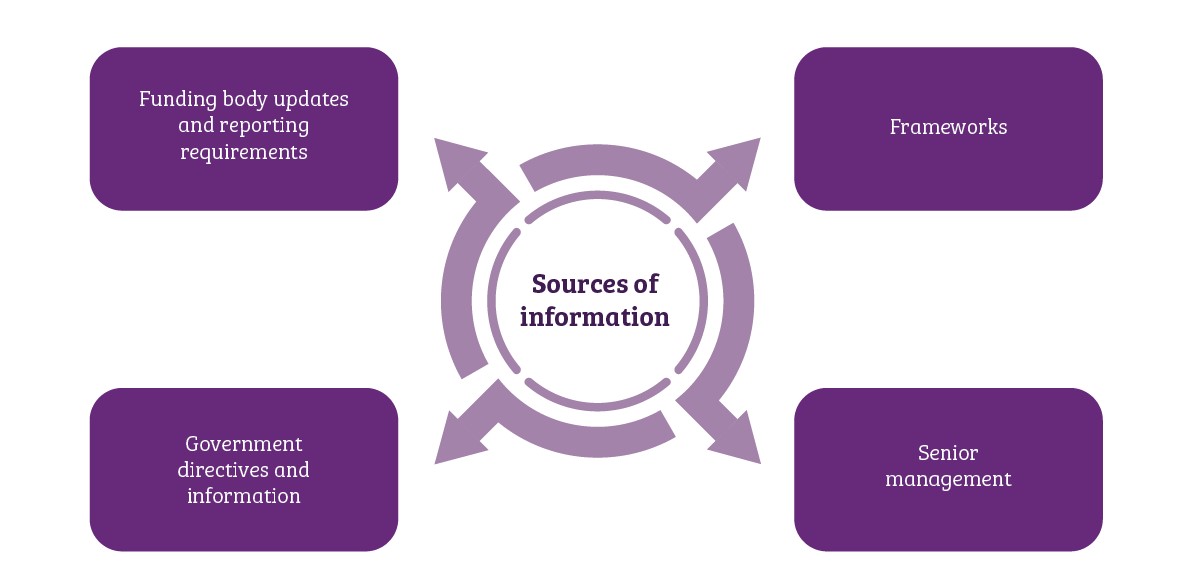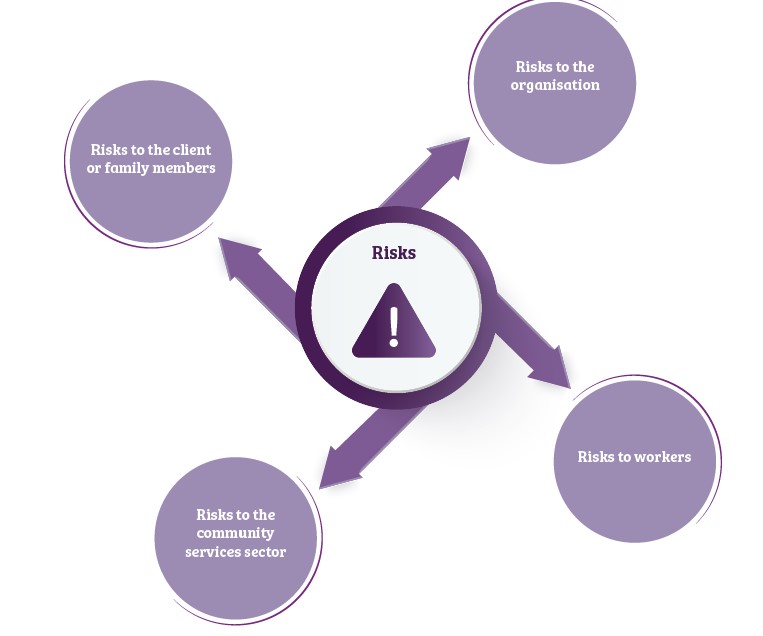Your role in monitoring compliance will vary from organisation to organisation and will depend on the type of service that you are working in. You will need to understand how to research compliance in relation to your own work role and to act on the requirements for your role, as well as accessing specialist legal support when needed.
By the end of this chapter, you will understand:
- sources of information about areas of community services compliance
- strategies for researching compliance
- the scope of compliance requirements in your own work role
- risks, penalties and consequences of noncompliance
- how to access specialist advice about compliance.

Regardless of the sector of community service that you work in, your role and the clients and stakeholders who you work with, compliance will have an important impact on your day-to-day work. There is no doubt that, at times, compliance can seem onerous but when it is viewed through the lens of improving outcomes and safety for your clients and their families and the safety of yourself, your colleagues and other stakeholders, compliance is one of the more important functions of a community services leader.
Break into groups of five or six (face-to-face or remotely) and spend ten minutes brainstorming all of the areas of compliance that you and your team might be responsible for over a twelvemonth period.
| Activity 1A |
|---|
|
Compliance Areas Discussion Break into groups of five or six (face-to-face or remotely) and spend ten minutes brainstorming all of the areas of compliance that you and your team might be responsible for over a twelvemonth period. As a class, compare lists. Are you surprised by how many areas of compliance there are? |
Policies and Procedures
Your organisation’s policies and procedures are useful sources of information about compliance requirements. You can access policies and procedures via an intranet or online site in your workplace, or as a print document. One of the main purposes of an organisation’s policies and procedures are to ensure legislative and ethical compliance. All of the information that you need to maintain and monitor compliance should be there somewhere.
Performance Planning and Review
Performance planning and reviewing documentation is useful in establishing previous compliance approaches which have existed in the workplace in order to build on these in an effective way. Examine what has happened previously in compliance areas and share notes, minutes, agendas and ongoing performance plans with your work team.
Mentors and Role Models
There are often people in your workplace who are more experienced in compliance than you. Access the support of these people either through a formal mentoring arrangement or by looking to them as role models. Ask them questions about their approach and seek out information and guidance to help inform your own compliance activities. It is often much easier to apply existing documents, information and guidelines than to reinvent your own.
| Activity 1B | |
|---|---|
| Identify a source of information for each of the following areas of compliance. Write a question you could ask or find out about in relation to each area. Write your information into a table. | |
| Source of information | Question |
| Workplace health and safety | |
| Industrial relations | |
| Duty of care | |
| Anti-discrimination | |
| Work/role boundaries | |
| Accreditation requirements | |
| Auditing/inspections | |
| Workplace practices | |
| Legislative compliance | |
| Compliance in communication | |

There are several strategies you can use for researching sources of information about compliance for your organisation. Your approach to research should be appropriate for the situation and for the time and human resources you have available. Some sources of information about compliance include:
How to Access Sources of Information
You will need to be pro-active and motivated to access sources of information about compliance. In a community services workplace, there is often a large amount of written information which is sent to and shared amongst workers and leaders. This can become overwhelming, and it is all too easy to ignore information and decide that you will leave things until another day.
It is vital that you assign time and resources to the task of accessing information about compliance. You should schedule regular tasks within your time planner to meet and find out about compliance requirements.
This could include:
- Attending senior leadership team meetings
- Researching online information through portals, websites, teleconferences and webinars
- Dedicating time each month to seek out information about compliance from funding bodies
- Maintaining regular communication with peak bodies and associations
- Linking with other professionals in similar roles to understand their approach to compliance
- Ensuring that compliance is front of mind when conducting team meetings and interactions with other staff members in your work team
- Aligning compliance requirements with your organisation’s vision and strategic direction
The way you access information will vary depending on your own work role and the specific community services area in which you operate.
| Case Study |
|---|
| Jenaro leads a community services team in the northern suburbs. He wants to help his team understand that compliance is not simply an administrative task that they need to fit in with their ‘real work’ but rather a tool for helping them go above and beyond what is expected in their work practices. He goes online and accesses the document ‘Community Services Quality Governance Framework.’ He reads the document carefully then uses it for the basis of a new format in their regular team meetings which he calls ‘Going above and beyond.’ He challenges his team to look for ways they can go above the compliance requirements in their daily work practices, and sets aside time to celebrate their achievements. https://www.dhhs.vic.gov.au/sites/default/files/documents/201810/Community%20services%20quality%20governance%20framework_0.pdf |
|
Activity 1C |
|---|
|
Researching Compliance to go Above and Beyond Go online. Access the document in the case study above. Can you identify three ways you could apply this document to the principle of going ‘above and beyond’ in compliance requirements in a specific area of community services work which interests you? Write a paragraph about your ideas which includes at least two references to this document. |
It is incumbent on each person who cares for children and young people to be aware of their obligations under the Charter, Rights of the Child and the CYFA 2005 (or equivalent legislation in your state or territory) and it is also incumbent upon each supervisor or leader to ensure that the members of their team are aware of and compliant with these obligations.
It is important that you are able to research and apply the various areas of compliance which are relevant to your workplace and your own role in the organisation. You need to know how to find information and understand how it is relevant to your role and the community services you provide.
Understanding Your Role
You can look to your position description or job statement to understand your own role in the organisation. This is a useful starting point for making a connection between your role and your compliance requirements. Your position description will include:
- Your duties
- Your reporting requirements
- Who you report to in the organisation
- Who you are responsible for supervising
- Your areas of accountability and responsibility
You can also speak to your direct supervisor to help clarify your role in the organisation.
Sometimes work roles can change, such as when you gain a promotion. This can lead to a change in compliance requirements, so it is important to ask for a new position description or a statement of your responsibilities when this occurs.
Compliance obligations exist in a number of areas and generally fall into one of the following categories:
Industrial Relations
Industrial relations compliance is usually the domain of the organisation’s HR department with support from its supervisors and their teams. It includes things like employment practices (ensuring that employee entitlements are honoured etc.), hiring practices, enterprise agreement negotiations, contract negotiations and so on. It also incorporates antidiscrimination in employment.
| Think |
|---|
| What are some changes that might occur in your work role when you gain a promotion? How might this align with changes to compliance responsibilities? |
Workplace Health and Safety
Every organisation in Australia has a legal obligation to meet the workplace health and safety (WHS) obligations set out in the relevant legislation for their state or territory. These obligations include risk management, compliance and reporting requirements and all employees have a role to play in safety. Generally, supervisors have an increased obligation in relation to workplace safety and compliance.
Duty of Care
Duty of care is the legal requirement to take reasonable care to protect the children and young people in your care from foreseeable injury (keep in mind that an injury is not only physical and includes emotional injury as well). In your role as a supervisor or leader, you are likely to have a higher duty of care than that of the members of your team. You may well also owe a duty of care to the people you work with, visitors to your unit and to the families of the children and young people who you care for. Monitoring and managing compliance plays an important part in fulfilling your duty of care responsibilities.
| Website |
|---|
| Victoria’s WorkSafe website has a section related to compliance and enforcement. Visit the site and download the PDF called ‘WorkSafe occupational health and safety compliance and enforcement policy:’ https://www.worksafe.vic.gov.au/resources/worksafe-occupational-health-and-safety-compliance-and-enforcement-policy |
| Activity 1D |
|---|
|
WHS Compliance Choose one section of the PDF from the website above and write a dot point summary explaining the key points. Share your summary with a colleague, co-worker or your trainer. |
Anti-Discrimination
Cultural safety for children and young people is an important aspect of community services work, as is the creation of connection with culture as one of the building blocks to resilience. There are many benefits to organisations having culturally diverse workplaces and to individuals working within culturally rich and diverse environments (remember that culture does not refer only to ethnicity). There are also legislative requirements around anti-discrimination, and it is the responsibility of supervisors and leaders to ensure that these requirements are complied with.
Work/Role Boundaries
Monitoring professional boundaries and ensuring that members of your team are operating within their scope of practice is important in ensuring the safety of the children and young people in your care as well as that of the members of your team.
Accreditation Requirements
In some cases, it will be your responsibility to ensure that all people coming into your service are appropriately licensed or credentialed to be there. This might include working with children checks, trade certified, first aid qualifications, police checks and so on.
Auditing/Inspections
There are often audits and inspections that it will be your responsibility to arrange. This might be WHS audits, building inspections, equipment checks, first aid kit checks and so on.
Statutory Reporting Requirements
Do you have statutory reporting requirements? For example, incident reporting, financial reporting and WHS? If your role involves meeting statutory requirements, you need to ensure that you document these requirements, understand when they are needed and take action to meet them in full.
Workplace Practices
In many sectors of community services there are compulsory workplace practices which must be implemented and monitored. For example, LAC documentation, critical incident reports, cultural plans, participation in care teams and so on. You should ensure that you understand the requirements for your workplace and that you apply them to your own role.
Legislative Compliance
The community services sector is heavily regulated and, as we saw earlier in this resource, there are many areas of legislation which impact different sectors. This is particularly relevant when working with children and young people and regulatory compliance is an important part of a leader’s role. This incorporates staying up to date with legislative changes and communicating those changes to members of your team.
Compliance in Communication
Many organisations have compliance requirements regarding communication. Community services organisations need to comply with the Australian Privacy Principles and will have policies and procedures which align with these requirements. They may also need to comply with other requirements, such as those relating to record keeping and client information, confidentiality and privacy.
At an organisational level, there may be compliance requirements related to templates, logos, branding, use of websites and documents and internal and external communication.
| Case Study |
|---|
| Renaldo is developing a COVID safe plan for his community services work site. He knows there are many workers on the site who speak a language other than English. He visits the website to access templates and information in the community languages which are most relevant to his work team and uses these to develop specific and culturally and linguistically appropriate plans for the workplace. https://www.coronavirus.vic.gov.au/covidsafe-plan#covidsafe-plan-in-languages-other-than-english |
In some areas, there can be legal risks of non-compliance including fines and even imprisonment. There are also other risks such as fines to the organisation, cancellation of licensing, loss of contracts and so on.
Risks
There are risks associated with failing to comply with legal requirements in community services. These include:

Risks can relate to a specific individual or situation, or they can be more far reaching, with application to whole work teams, workplaces or the sector. For example, failure to comply with risk assessment requirements could have risks for:
- The client: they may be physically or emotionally harmed
- The worker: they may be injured at work
- The organisation: there may be loss of productive work time, increased costs or damage to reputation
- The community services sector: the reputation of the sector may be impacted in the eyes of the wider community
Workplace Consequences
The consequences of non-compliance may be at a workplace level. This could include:
- Loss of clients
- Impact on reputation as a provider
- Reputation as an employer
- Increase in staff absenteeism and loss of staff away from the area or workplace
| Activity 1E |
|---|
|
Identify the risks Make a diagram similar to the one above. Use the diagram to show the risks which might exist in a community services workplace in relation to a client confidentiality breach where notes about a client are accidentally sent to a family member who was not meant to have access to the information.; |
| Resource |
|---|
| NDIS compliance and enforcement policy: https://www.ndiscommission.gov.au/about/compliance-and-enforcement/our-compliance-and-enforcement-approach#:~:text=The%20NDIS%20Commission%20uses%20a,notices%20and%20court%2Dbased%20outcomes. |
Issues and Breaches
It is almost inevitable that if you are monitoring and managing compliance effectively, you will identify issues and breaches from time-to-time. The action that you take will, of course, vary depending on the type of issue and on your organisation’s processes, policies and procedures. There are, however, some key elements of addressing issues and breaches which remain consistent:
- Responding in accordance with your organisation’s policy and procedures
- Responding in accordance with legislative requirements
- Acting in the best interests of the children and young people in your care
- Recording and reporting the issue and the actions taken to resolve it
- Following up to ensure that the actions taken have successfully resolved the issue
It is important that you understand issues and breaches which relate to the area of community services in which you operate. Ensure that you monitor performance activities in your work team and that you are aware of compliance requirements. For example, if your work relates to people who have a disability, you should be aware of the compliance requirements of the NDIS.
| Activity 1F |
|---|
|
NDIS Compliance and Enforcement Use the NDIS compliance and enforcement document to make a list of at least three possible breaches which might occur and the consequences of each one. Write a sentence to explain what you could do to avoid these breaches occurring in a community services workplace with which you are familiar. |
Compliance can be a complicated area and it is always wise to seek specialist advice if you have an issue that you have not come across before or where the way forward is unclear. Your organisation’s policies and procedures are always a good place to start, but you could also consider:
- Industry associations
- Specialist advisers
- Mentors
- Industry journals
- Industry newsletters
- Local government
- State government departments
- Commonwealth government departments
- Regulatory agencies
- Legislation
- Practice notes
- Specialist legal advice
The Cost of Specialist Advice
It is important to consider the cost of accessing specialist advice in relation to compliance, and also the potential cost of NOT accessing it. Think about what information you need and consider how to find what you need to know. There may be several possible ways to access specialist advice, such as contacting someone in your own professional network or reading a publication from a peak body. If you access specialist advice in this way, make sure the information is up-to-date and appropriate for your own workplace and the situation. Sometimes it can be more cost effective in the long run to pay for specific, specialist advice than to spend your own time researching and accessing information which may or may not be appropriate.
One Step at a Time
Think about whether you can access the information you need from regular sources of compliance information first. You could consider your own organisation’s policies and procedures, or a framework from a regulatory or funding body. If you cannot find the information you need or you are not sure how it applies to your situation, look at other options for advice.
| Example |
|---|
|
The Child Safe Standards Compliance Monitoring Framework (2018-2019) is available online on the Department of Families, Fairness and Housing, State Government of Victoria website. |
| Review questions | |
|---|---|
| 1 | Identify two sources of information |
| 2 | How could you find information about your role in relation to compliance in your workplace? |
| 3 | Outline an area of community services work where you might have a statutory requirement that you need to complete as part of your role. |
| 4 | Explain how you would access specialist advice in relation to your own area of interest within the community services sector. |
